13 Mistakes Everyone Makes When Storing Canned Foods
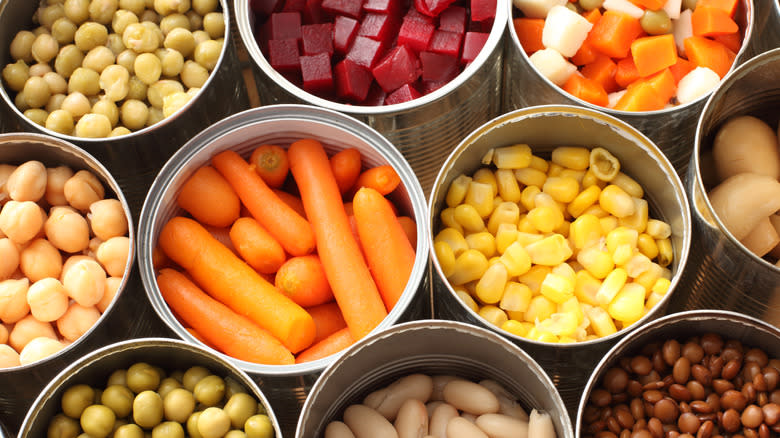
Canned goods, be they store-bought or home-canned in jars, are essential in any pantry. They allow you to have food that doesn't rely on the refrigerator, freezer, or electricity, which means you can still eat if your power goes out. They also help preserve food that's out of season and ensure that you have something to eat that's already pretty much cooked when you're very tired. They seem like sturdy objects that should be easy to store, but that's not true.
Canned goods aren't completely safe from problems, and some very common storage mistakes can lead to unsafe food and wasted money. The mistakes aren't always intuitive, and many people make them out of habit. Once you understand why these mistakes have the effect they do, you'll be better able to store canned goods properly. Take a look at these 13 mistakes everyone makes when storing canned food so that you can ensure the canned goods you have last a lot longer.
Read more: 16 Little-Known Facts About Salt
Stacking Too Many Cans Or Jars On Top Of Each Other
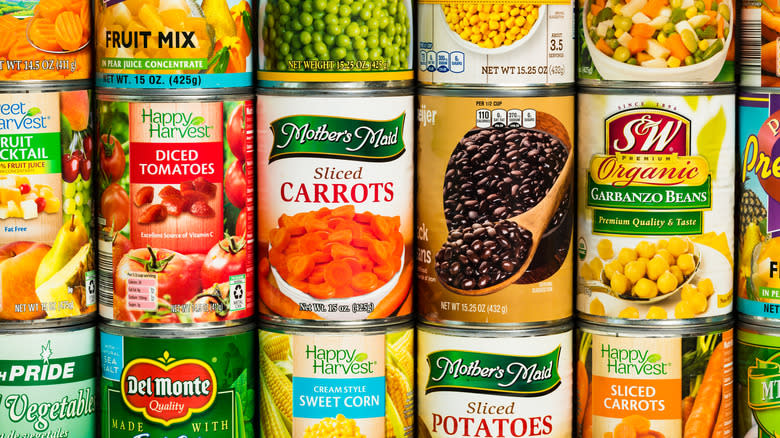
When you don't have a lot of storage space for canned goods, stacking cans and jars on top of each other looks like a good idea. Many cans are made so that the bottom of one fits just inside the raised rim on the top of another, so of course people will store those cans stacked in columns. Unfortunately, something manufacturers haven't made obvious to the average consumer is that those stacks can actually damage the cans. As you add more cans to the stack, the cumulative weight of the cans presses down on the cans at the bottom. This can make the metal bend ever so slightly which puts the integrity of any seals at risk, such as those on pop-tops or on jars with lids where too much weight in the center might make the edges of the lid lift up.
For most cans and jars, stacking two of them shouldn't be a problem. But don't add a third to that stack, and don't place very heavy items on top of even one can. Use smaller storage shelves or stackable bins placed on the main pantry shelves to add more storage space if needed. If possible, place something solid but light, like a sheet of stiff plastic, over the bottom row of cans to further protect the seals.
Keeping Them For More Than A Year When You Don't Have To
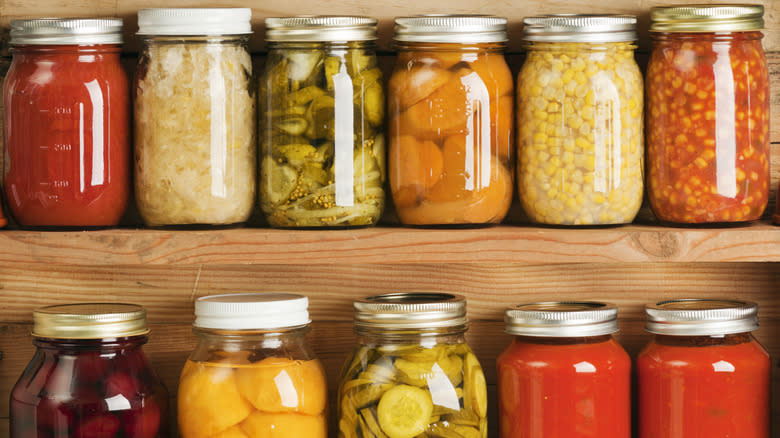
Canned goods, whether commercial or home-canned, are meant to last a long time. But "a long time" is relative, and how soon you should use up the food differs depending on who canned it. For commercially canned food, manufacturers may stamp a can with a best-by date that's a couple of years away, and the quality could remain very good for a time after that. But for home-canned food, you should use that up within a year. If it looks like you won't be able to use all of it up, throw it out, try giving some of it to neighbors, or remove the food from the jar and freeze it if it's a food that freezes and thaws well.
But that's not all. When you grab one of those jars for use, double-check the seal and look for signs of spoilage even if you're using it before a year has gone by. Unfortunately, storage conditions aren't always perfect, and those can make canned food go bad more quickly.
Not Following First-In-First-Out
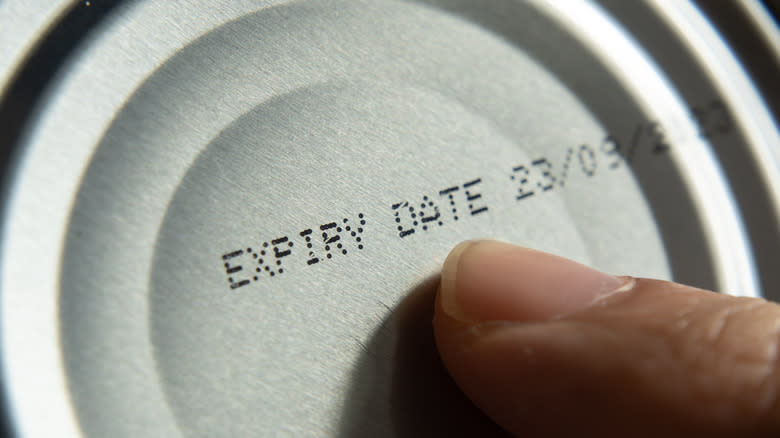
Want to know a great way to turn your pantry into an archaeological dig? Stuff a bunch of cans in back, and then don't ever touch them. Instead, every time you buy canned goods, place those at the front of the shelf and just keep eating and replacing those. Before you know it, you'll have a time capsule of old canned food in the back of the pantry.
Okay, that was obvious sarcasm, but it's based somewhat on what many people actually do. They place cans in the pantry, and when they go shopping next, they place more cans in front of those, never touching the older cans. Instead of letting some old food linger, use a system called FIFO -- first-in-first-out. When you place a bunch of cans in the pantry and then buy more the next time you shop, don't place the new cans in front. Place them in the back with the older cans in front, so you see those first when you go to get some food.
This assumes the best-by dates on the new cans are farther out than the dates on the older cans. If you somehow end up with new cans with a closer date, place those in front. FIFO depends on organizing cans by the best-by or expiration date.
Not Cleaning The Tops Or Cleaning Them Too Soon
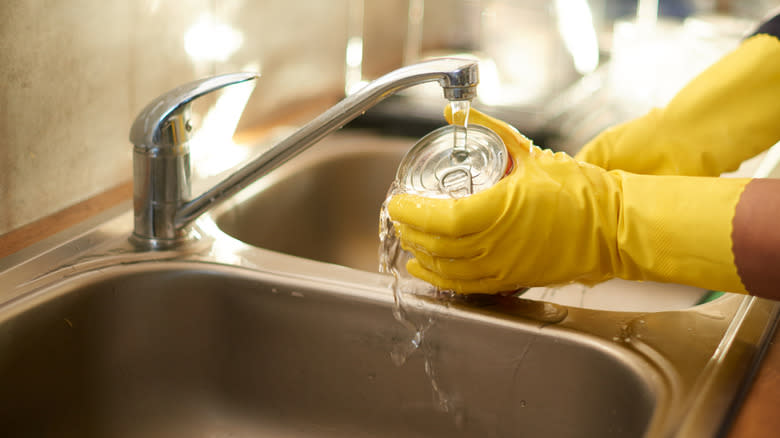
As with any horizontal surface, the tops of cans gather dust, bacteria, and whatever else happens to fall on them. If you were to cut into one of these tops with a can opener or push a pop-top down so that its seal breaks, you'd end up pushing that dust and gunk into the can and into the food. That's not only a gross image, but it could legitimately make you sick if the top happened to hold a drop of spoiled food or germs from someone's hands. Remember, a number of customers have probably handled that can before you did.
The solution is to wash the tops of each can -- put a little water on the top and then wipe the whole thing clean, including around the rim. But this also brings up the question of when to wash it. If you wash the cans right when you get home from the store, you have some nice, clean cans to use. But if you're planning to store the cans for a while, more dust will settle on the lids. That makes your previous cleaning pointless. It's best to wash the can tops when you're about to use them. You may also want to consider storing the cans upside down to help cut down on the dust that could fall on the tops.
Ignoring Dents
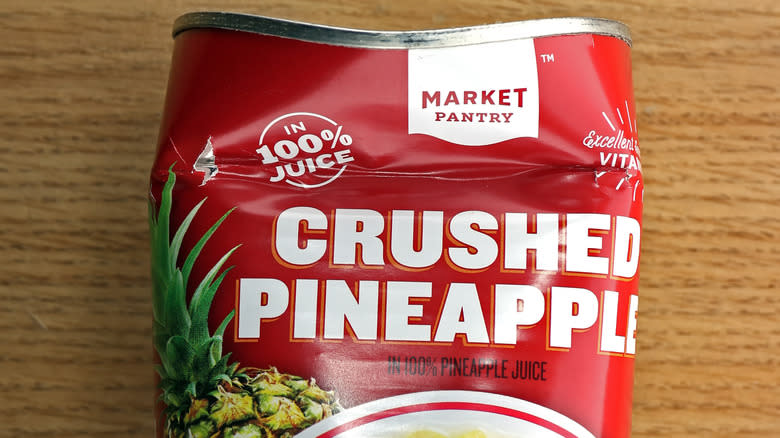
Dented cans are not as simple as they seem. Some dents are minor enough so that you can ignore them, but others make the canned goods unsafe to eat, even if the actual dent is small. You need to look both at the depth of the dent and where the dent is on the can. In general, deep dents are a bad sign; don't buy those. If you bought canned goods and dropped them, for example, you'll have to toss any that ended up with a deep dent.
The location matters, too. If the dent is on a seam, either on the side or near the top or bottom of the can, there's a chance that the seam has been compromised and that there could be a tiny opening. It doesn't take much to let germs in to spoil the food. And if the dent is right on the rim, throw out the can. This goes for even small dents, according to the University of Wyoming Extension.
Placing The Cans In Sunlight
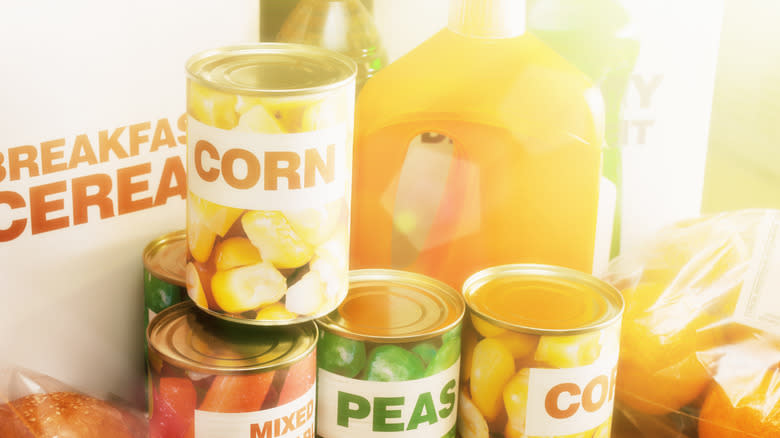
Sunlight is the enemy of long-term food storage, both for metal cans and glass or plastic jars. Sunlight affects these in two ways. One is that the UV rays can degrade the quality of the food over time and adversely affect the nutritional content. Using darker or opaque packaging can help to an extent, but it's not perfect because the food can still be affected in one more way.
When direct sunlight hits a container, it can heat up the container. Not only does the packaging heat up, but the food inside can as well. Each can has something called a headspace at the top, which is a pocket of air that allows for expansion of the food as it's being canned and processed in a hot water bath. If that headspace heats up, the increased hot air inside the can will expand and may cause a breach of the seal. Once that's open (even a tiny bit), germs can get inside, and that's a bout of food poisoning waiting to happen. Even if there's no breach, the added heat can accelerate spoilage.
Exposing The Cans To Too Much Moisture, Heat, Or Freezing Conditions
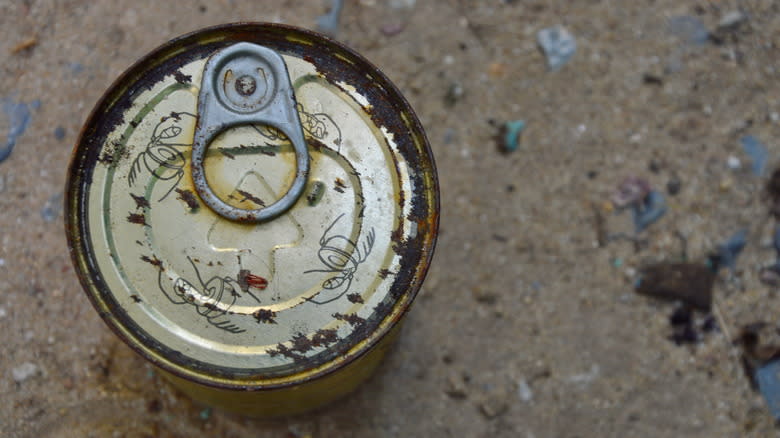
You'd think food stored in sturdy metal or glass would be well-protected from the elements. Unfortunately, that's not the case. Moisture, heat, and excessive cold can all damage the quality of the food, and in many cases, they can lead to spoilage. Moisture, be it from rain, a leak, a spill, or plain old humidity, can promote rust on metal cans and lids, which can eat through the metal, allow bacteria and dirt in, and allow the contents of the can to leak out.
Heat has essentially the same effect as sunlight on the temperature of the can, creating expansion, potentially breaching a seal, and promoting spoilage. Very hot temperatures over 95 degrees Fahrenheit can make any dormant microorganisms that are in the can start growing again, and you may want to consider disposing of those cans. Cold temperatures, especially freezing temperatures, can crack glass and plastic and ruin seals on metal. Canned goods need to be stored in moderate temperatures, preferably below 70 degrees Fahrenheit, but you can go to 85 degrees Fahrenheit if needed. Keep everything in a dark, dry spot away from heat sources, including electronics that give off heat.
Temporarily Storing Food In An Open Can In The Fridge
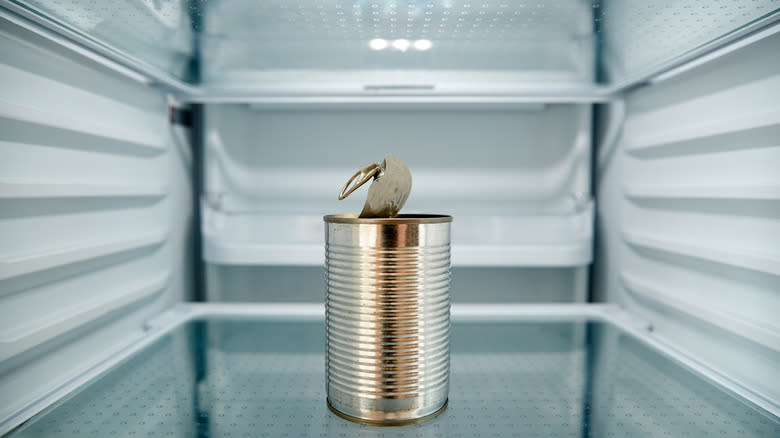
Most people have done this at least once: They've opened a can, put half the food into a bowl, and then shoved the can with the remaining food back in the fridge for the day. Turns out, that's a really bad idea. Once you open a can of food, the seal is gone, so the remaining food starts to dry out and spoil. Even if it's in the fridge, that open environment is not going to help the food's quality remain that great.
Also, odors from the food can travel throughout the refrigerator and affect any other food in there that isn't well-wrapped. Got butter in a dish with a loose cover? That butter might start smelling and tasting of canned spaghetti and meatballs. It only takes a minute to transfer the rest of the food into a container that you can cover tightly.
Boiling Canning Lids From Ball
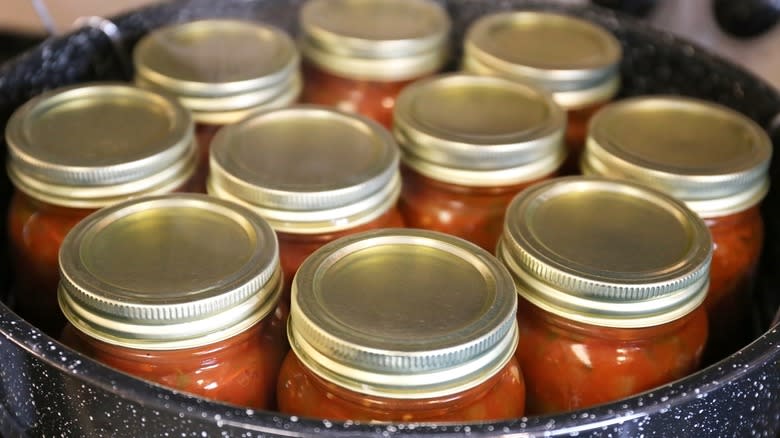
Ball is a major provider of equipment, supplies, and advice regarding canning foods at home. Among their products are glass mason jars and two-piece lids meant to seal those jars. The lids consist of a flat, round lid with a lining that softens in heat, plus a ring that screws down around the edge of the lid and the jar. In 2017, Ball changed how their lids were made, which led to a major change in how people were supposed to use them. And it was a change that, if not followed correctly, could ruin some jars.
Before 2017, when you sterilized lids for canning, you'd wash the lids with dish soap and water, and then you'd heat them up. You'd place the lids (both the flat lid and the ring) in boiling and then simmering water. Now, though, you don't have to heat them up because Ball changed the lining on the lids to plastisol. This means the lids don't need heating before forming a seal on the jar (although you'll still put the sealed jars in a water bath later on). If you don't feel comfortable with not heating the lids, you can still simmer them. Do not boil them as that will thin the plastisol and make it harder to form a good seal once you place the lid on the jar.
Using Older Jars For Home Canning And Storage
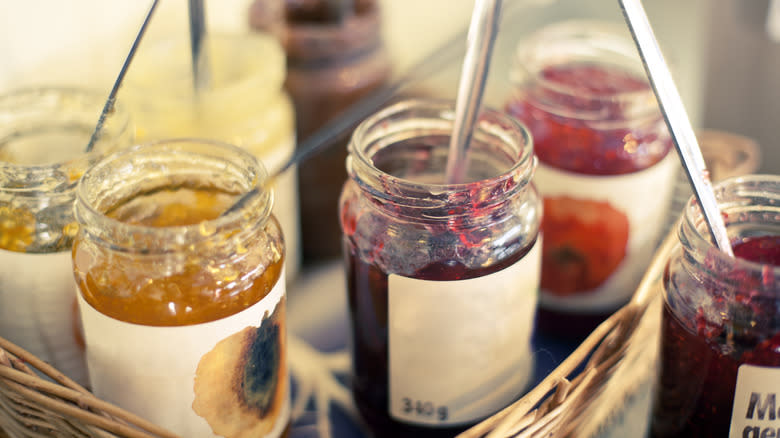
When you can foods year after year, you can either spend a lot of money on new supplies, or you can see if any of the materials you used in last year's batch are reusable. Some are, and some aren't. Newer glass jars that are in good condition are reusable, but be careful; always inspect the jars for cracks and other defects before reusing. It's common for jars to get little nicks and divots around the rim, and once you find those, you want to stop using the jar for things that need a sterile environment. The rings are reusable if they are in good shape, but the flat lid portion can only be used once.
Some people try to find older jars at thrift stores and garage sales, but these aren't always the best options, even if they were previously used only for canning. Older glass jars may not be tempered, and they may have tiny cracks that would expand when the jar is heated. And some jars may look like canning jars, but they weren't actually made for use in canning. It's often best to buy new jars and just reuse those until they develop defects.
Storing Only Home-Canned Goods
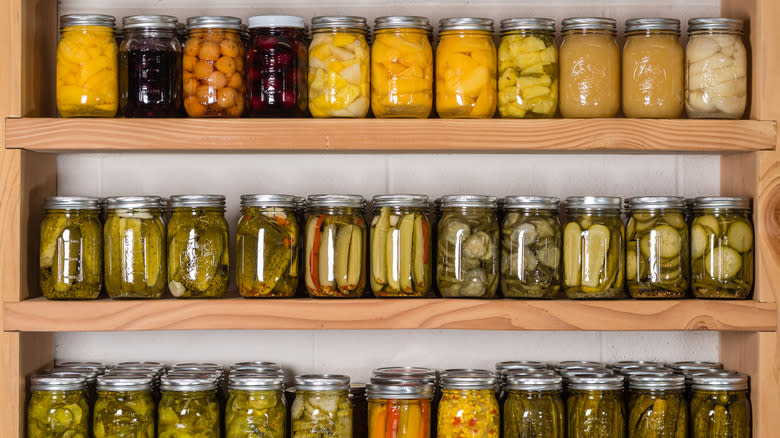
No matter how much you prefer home-canned goods, never store only home-canned goods in your pantry. This has to do with the fact that home-canned food is subject to spoilage and other problems much sooner than commercially canned food. Home-canned food is more at risk of developing issues with damaged lids and breached seals from acidic foods, and the risk of something going wrong during the canning process is always present.
Storing only home-canned goods could be restrictive in terms of variety unless you made the effort to can several different types of fruits, vegetables, sauces, and more. Have a mix of home-canned and store-bought foods that allow you to eat without getting bored by the food you have, and include other forms of shelf-stable foods like those that are freeze-dried. This is especially important if you're going for more self-sufficiency; you'll want different types of shelf-stable foods to ensure that if something happens to one form (like finding that your home canning didn't seal well), you have a few others that you can still eat.
Leaving The Rings On Home-Canned Jars
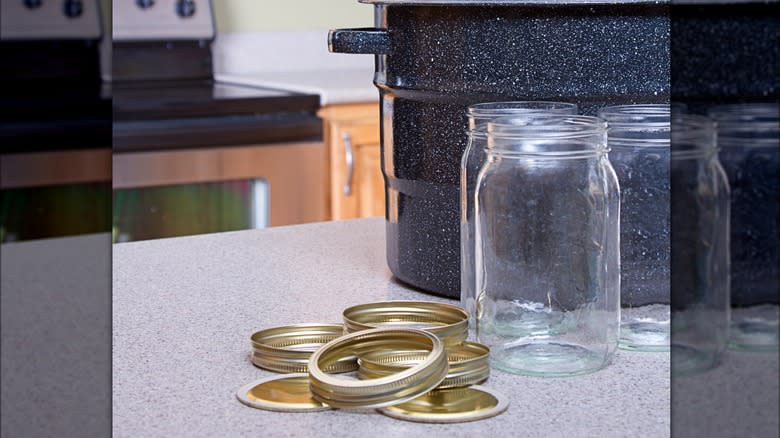
There are a few styles of jars and lids used in home canning, but the flat lid and ring are the most common. When you're canning the food, you place the flat lid on the jar and then tighten the ring over that. And most people leave both on the can from that point on until they open the can in the future. The problem is that if the seal on the lid breaks for whatever reason, you may not realize it until the food has had a chance to develop moldy spots and become impossible to save. This is because the ring hides the edges of the flat lid from view and keeps the flat portion relatively stable. You won't know anything is wrong until you remove the lid and see or smell the damage.
The rings can also trap moisture, either from the water bath or from condensation. That moisture can promote rust, as mentioned, and eat away at the seal. It's better to remove the rings before storing the finished jars. Once you open the can lid, you'll reapply the ring to help hold the flat portion down each time you put the jar back in the refrigerator.
Not Dating Home-Canned Food
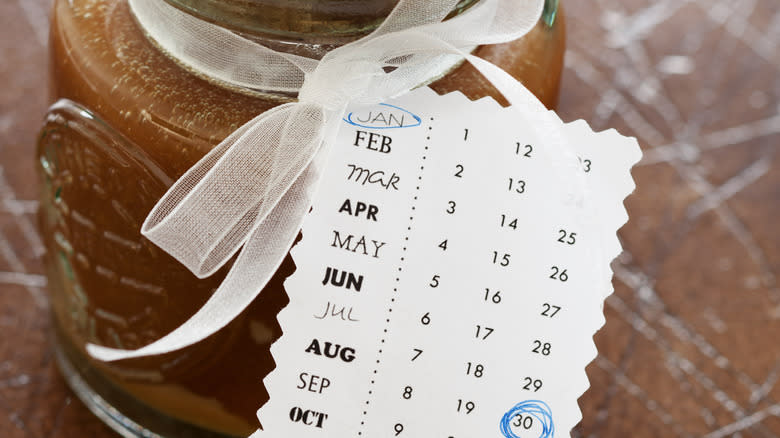
From freezer jam to seasonal fruit to tomato sauce, having a store of home-canned foods can be a really neat sight. You managed to preserve all that food, and now you'll be able to eat it all throughout the year, which should cut down on your grocery bill substantially. That is until you get tired of some of the food or find that you canned way too much. Now you've got a lot of older food just sitting there. If you label and date the cans, you'll know which ones you need to eat or toss as soon as possible. But if you didn't label and date the cans, you've got a problem.
As mentioned, home-canned food needs to be used up within a year. Many people do canning at different times of the year, so it's not as simple as noting that it's been one year and everything in the pantry needs to go. Some food may be only a few months old, while others are now sneaking past that 12-month mark. If none of these have dates, you might not remember which ones are the oldest. Label and date the jars as you finish each batch. You can buy canning labels for jars so you don't have to write directly on the glass.
Read the original article on Mashed

 Yahoo Lifestyle
Yahoo Lifestyle 
